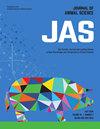LncRNA MSTRG.14227.1 regulates the morphogenesis of secondary hair follicles in inner mongolia cashmere goats via targeting ADAMTS3 by sponging chi-miR-433
IF 2.7
2区 农林科学
Q1 AGRICULTURE, DAIRY & ANIMAL SCIENCE
引用次数: 0
Abstract
The cashmere goat is a type of livestock primarily known for its cashmere. Cashmere has a soft hand feel and good luster. It is a vital raw material in the textile industry, possessing significant economic value. Improving the yield and quality of cashmere can accelerate the development of the cashmere industry and increase the incomes of farmers and herdsmen. The embryonic stage is the main stage of the formation of hair follicle structure, which directly affects the yield and quality of cashmere. With the rapid advancements in modern molecular technology and high-throughput sequencing, many signaling molecules have been identified as playing critical roles in hair follicle development. Long non-coding RNA (lncRNA), which lacks protein-coding ability and exceeds 200 nucleotides in length, has been discovered to play a role in hair follicle development. In this study, the lncRNA MSTRG.14227.1, which is associated with the morphogenesis of secondary hair follicles, was screened and identified based on previously established lncRNA expression profiles derived from skin tissues of cashmere goats at different embryonic stages. This lncRNA has been shown to inhibit the proliferation and migration of dermal fibroblasts. Furthermore, we confirmed through bioinformatics analysis and dual-luciferase reporter assays that lncRNA MSTRG.14227.1 can function as a sponge for chi-miR-433, thereby alleviating the inhibitory effect of chi-miR-433 on its target gene ADAMTS3. In conclusion, the results of this study suggest that lncRNA MSTRG.14227.1 can inhibit the morphogenesis of secondary hair follicles through the chi-miR-433/ ADAMTS3 signaling axis.LncRNA MSTRG.14227.1通过海绵化chi-miR-433靶向ADAMTS3调控内蒙古绒山羊次生毛囊的形态发生
羊绒山羊是一种主要以其羊绒而闻名的牲畜。羊绒手感柔软,光泽好。它是纺织工业的重要原料,具有重要的经济价值。提高羊绒的产量和质量,可以加快羊绒产业的发展,增加农牧民的收入。胚胎期是毛囊结构形成的主要阶段,直接影响羊绒的产量和品质。随着现代分子技术和高通量测序技术的快速发展,许多信号分子在毛囊发育中起着至关重要的作用。长链非编码RNA (lncRNA)缺乏蛋白质编码能力,长度超过200个核苷酸,已被发现在毛囊发育中起作用。本研究基于先前建立的不同胚胎期绒山羊皮肤组织lncRNA表达谱,筛选并鉴定了与次生毛囊形态发生相关的lncRNA MSTRG.14227.1。该lncRNA已被证明可以抑制真皮成纤维细胞的增殖和迁移。此外,我们通过生物信息学分析和双荧光素酶报告基因检测证实,lncRNA MSTRG.14227.1可以作为chi-miR-433的海绵,从而减轻chi-miR-433对其靶基因ADAMTS3的抑制作用。综上所述,本研究结果提示lncRNA MSTRG.14227.1可通过chi-miR-433/ ADAMTS3信号轴抑制次生毛囊的形态发生。
本文章由计算机程序翻译,如有差异,请以英文原文为准。
求助全文
约1分钟内获得全文
求助全文
来源期刊

Journal of animal science
农林科学-奶制品与动物科学
CiteScore
4.80
自引率
12.10%
发文量
1589
审稿时长
3 months
期刊介绍:
The Journal of Animal Science (JAS) is the premier journal for animal science and serves as the leading source of new knowledge and perspective in this area. JAS publishes more than 500 fully reviewed research articles, invited reviews, technical notes, and letters to the editor each year.
Articles published in JAS encompass a broad range of research topics in animal production and fundamental aspects of genetics, nutrition, physiology, and preparation and utilization of animal products. Articles typically report research with beef cattle, companion animals, goats, horses, pigs, and sheep; however, studies involving other farm animals, aquatic and wildlife species, and laboratory animal species that address fundamental questions related to livestock and companion animal biology will be considered for publication.
 求助内容:
求助内容: 应助结果提醒方式:
应助结果提醒方式:


